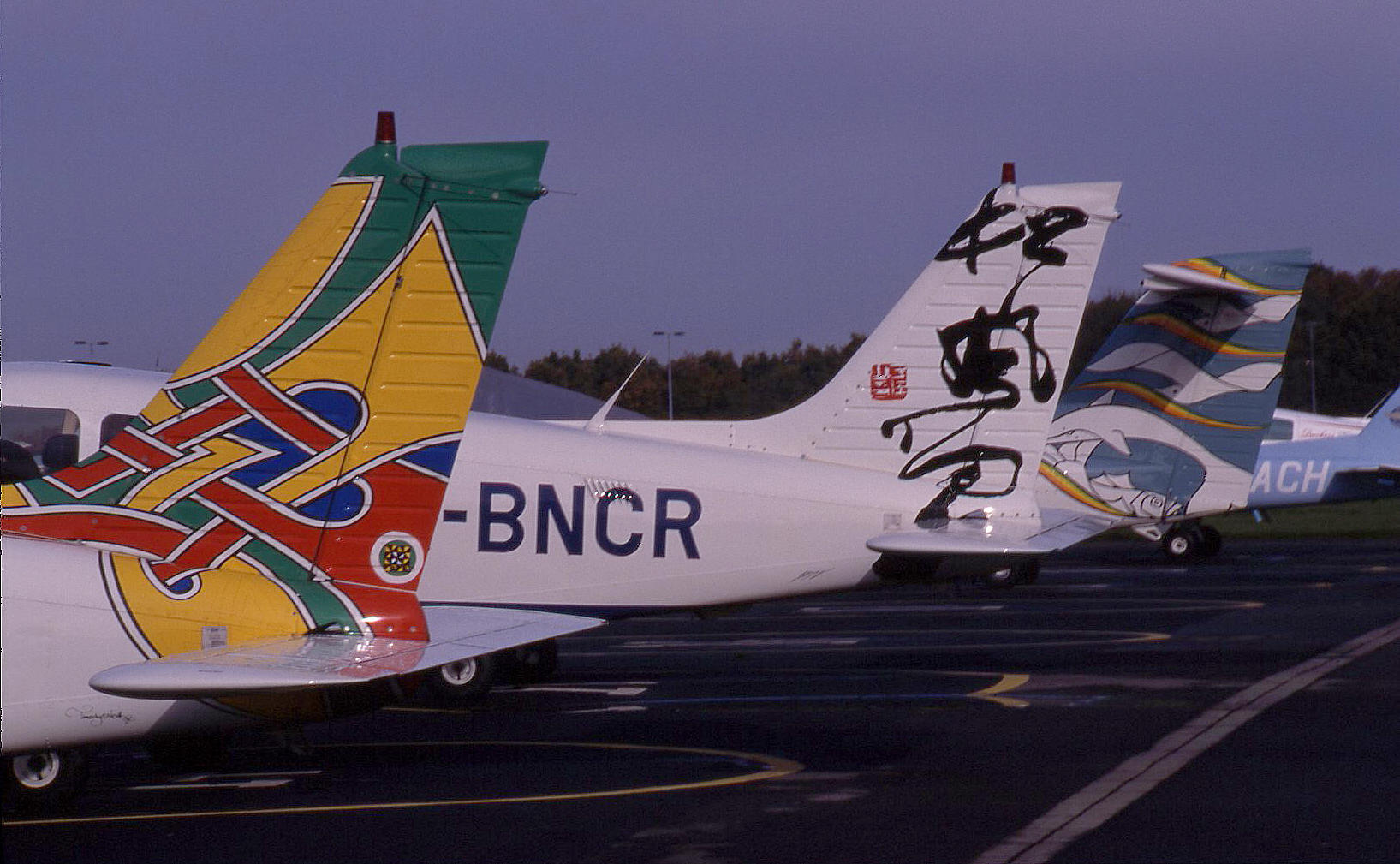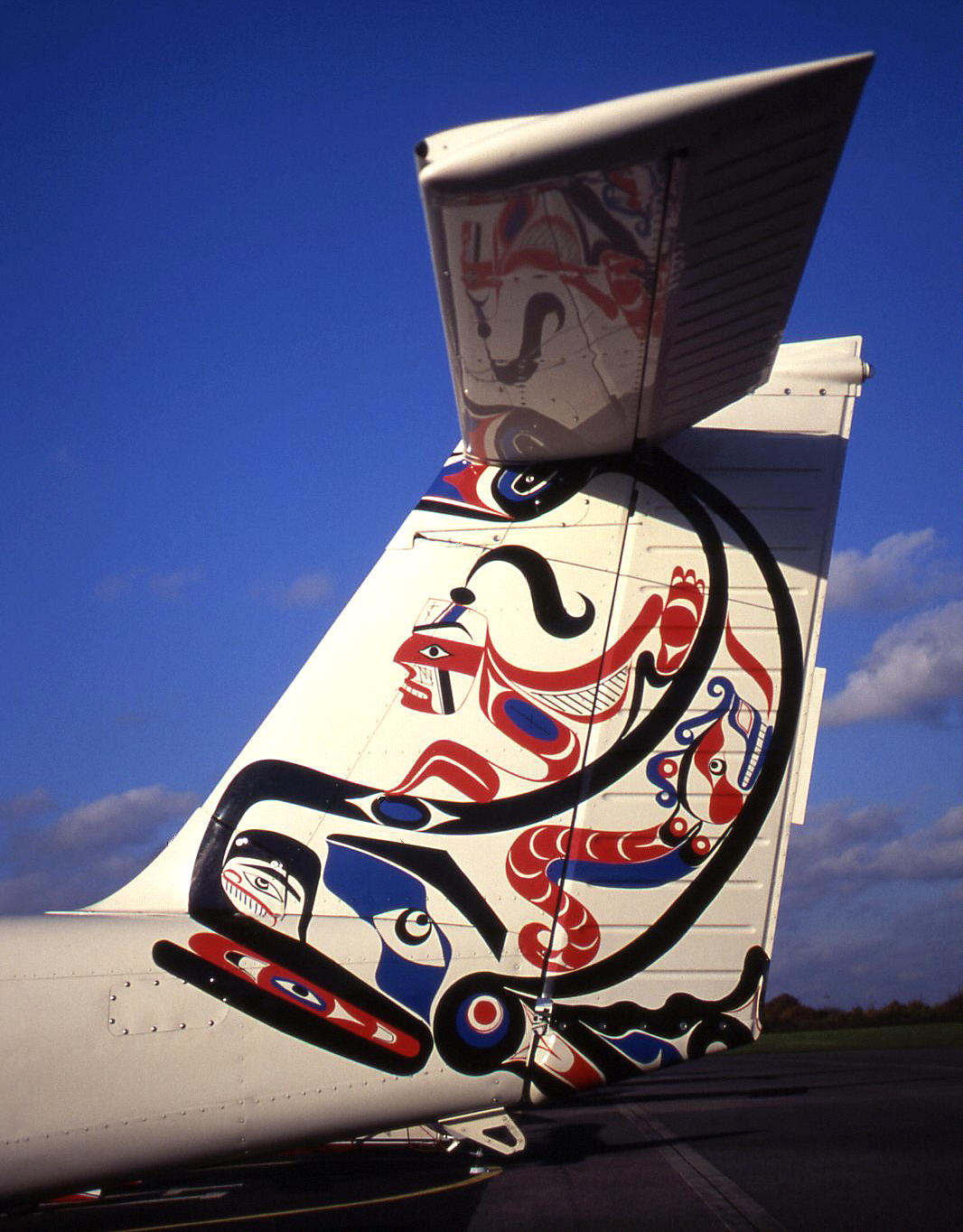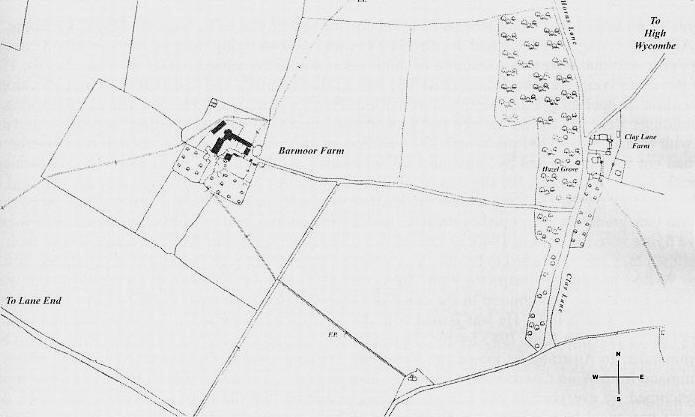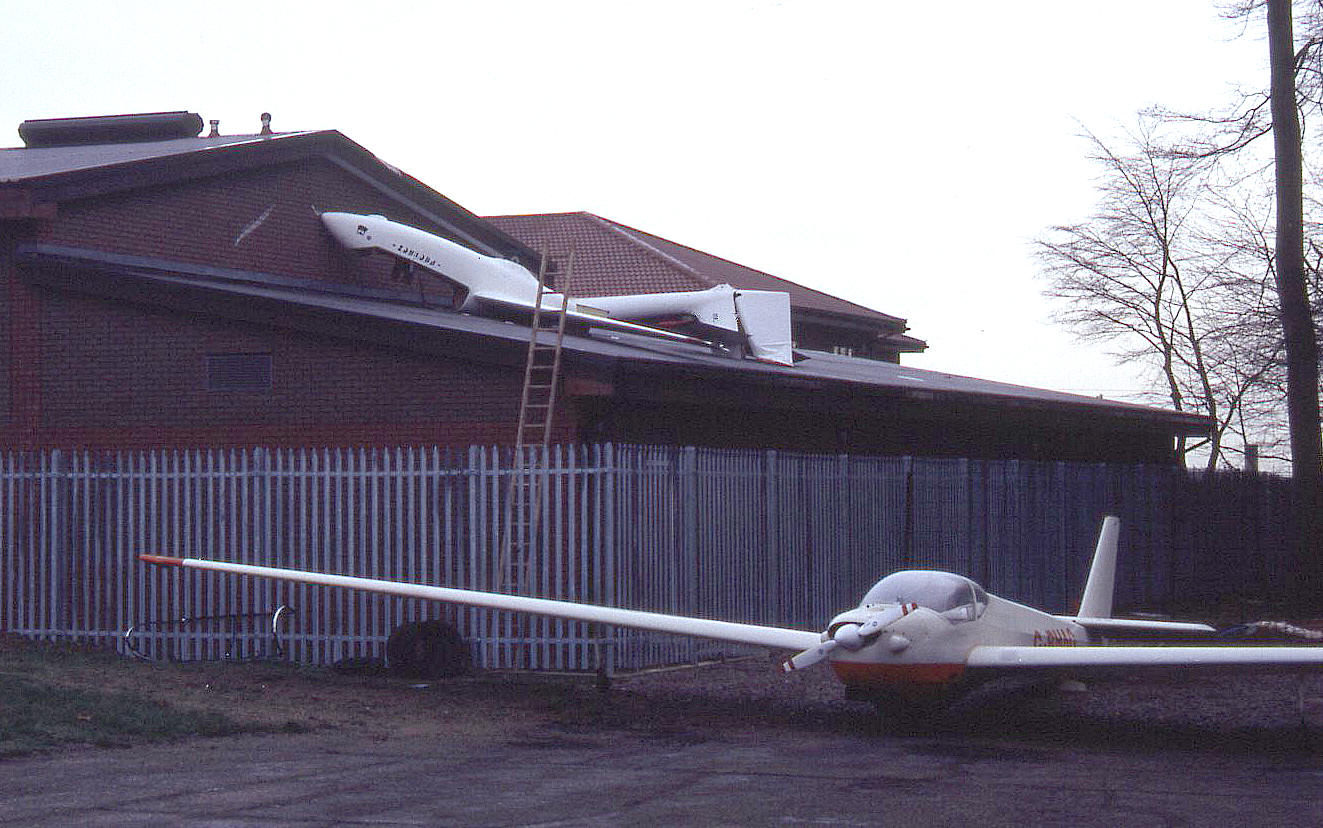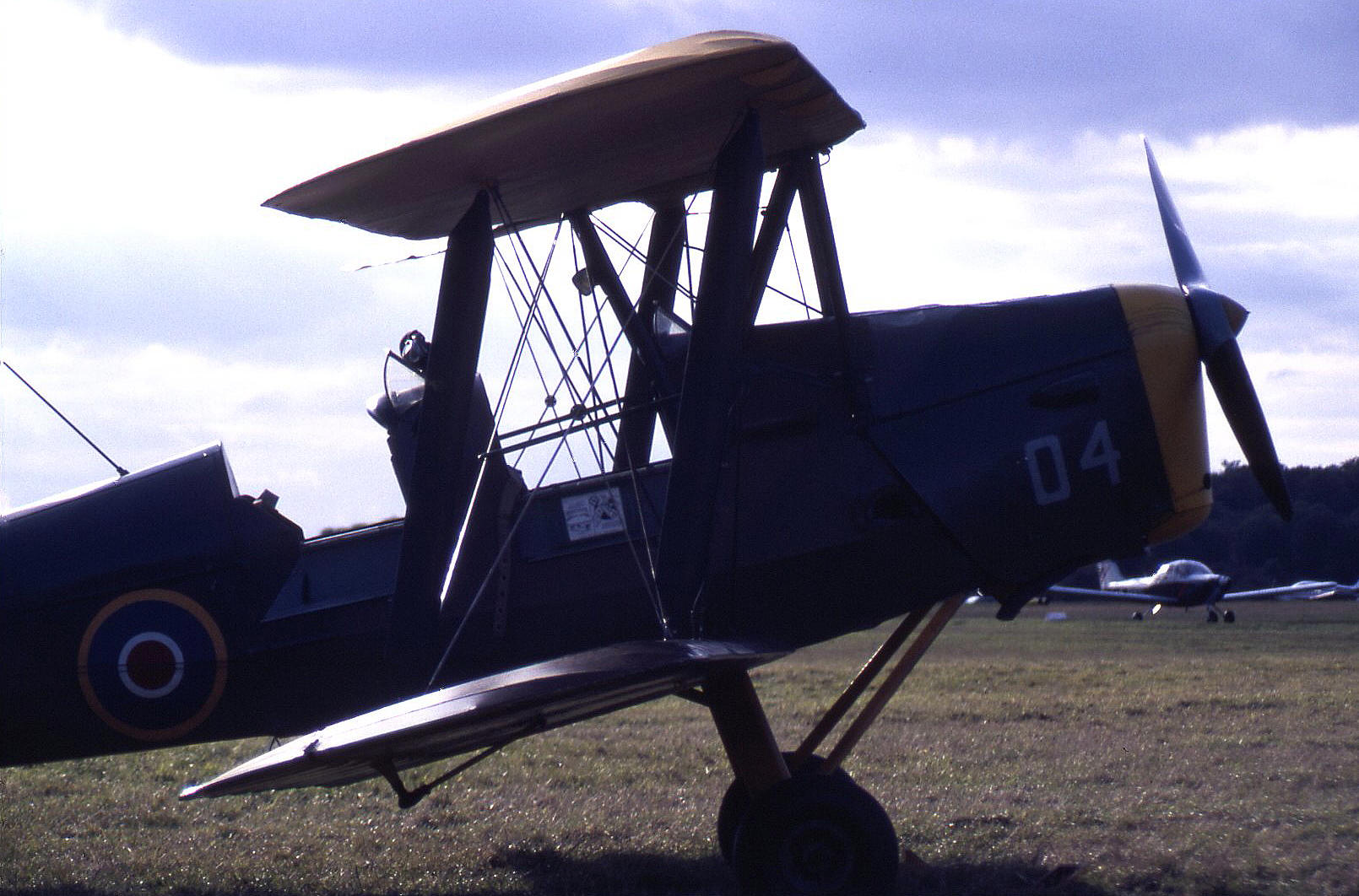Wycombe Air Park
HIGH WYCOMBE see also HIGH WYCOMBE WW1
HIGH WYCOMBE see also BOOKER
WYCOMBE AIR PARK: Civil regional airport*, (later military aerodrome in WW2 see BOOKER), later civil aerodrome and popular gliding site. Plus considerable helicopter activity
Note: This picture (2018) was obtained from Google Earth ©
(Originally known as BARMOOR FARM and MARLOW AIRPORT)
Note: All pictures by the author unless specified.
Note: WYCOMBE AIR PARK is renowned for having the 'Chilton weather effect' whereby quite sudden and dramatic changes of weather, not forecast, can take place. My caption for this fourth picture is; "Squeezed back through bad weather." This was after a flight to HOOK (SCOTLAND FARM) and POPHAM which took place in benign conditions. On the way back however, the weather had worsened to a quite remarkable degree. From memory, and with advice over the radio, we found a way around the worst of it by skirting around via Prices Risborough.
Operated by: From 1965: Airways Aero Club
1980s: Airways Association Ltd
2000: Airways Aero Association Ltd
2007: Arora Family Trust
Charter/air taxi: Post 1945: Aerial Enterprises
AIRWAYS AERO ASSOCIATION and BRITISH AIRWAYS FLYING CLUB PICTURES
As you will see I have included several pictures of the BA decorative tail schemes. Without any doubt, when introduced on their airliners, it certainly put BA 'on the map' globally, and they produced a great deal of controversy. This controversy was certainly evident when they appeared on the BA Flying Club aircraft. As I remember, the majority of people disliked the idea.
But of course, I suspect the project was actually very successful, in as much as controversy generates publicity. And, as somebody famously said, "There is no such thing as bad publicity." A somewhat cynical point of view, but, I can see the point.
The seventh picture, taken in November 1999, shows the then 'new' and 'resolved' tail colour scheme, which is still (in 2016) pretty much what we have today.
Flying schools: Post 1945: Airways Aero Association later known as British Airways Flying Club, Wycombe Air Centre
Gliding: Since 1970s at least? Booker Gliding Club
1981: Airways Gliding Club Thames Valley Gliding Club Wycombe Gliding School
Helicopter ops: Post 1945: FlightWorks Group, Helicopter Services, Virgin Helicopters
Maintenance: Post 1945: Air training Services, Wycombe Air Centre
Military activities: RAF Training Command, see BOOKER
Museum: Blue Max museum (No longer in existence but see my article on museums)
Aircraft restoration: Personal Plane Services specialising in classic aircraft
Location: Between B482 and M.40, 2.5nm SW of High Wycombe
Period of operation: 1930s till today
Notes: The first three maps are provided courtesy of Darren J Pitcher.
The 2000 map is reproduced with the kind permission of Pooleys Flight Equipment Ltd. Copyright Robert Pooley 2014.
Runways:
1966: 07/25 735x23 hard
Three grass runways (length unknown) were: 03/21 17/35 13/31
1990: 07/25 735x23 hard 07/25 610x23 grass 17/35 787x30 grass
2000: 07/25 735x23 hard 07/25 610x23 grass 17/35 695x30 grass
Notes: *It is claimed that when this site was originally laid out, it was intended to become a regional airport. As far as I can determine, it never achieved this status as WW2 intervened.
NOTES: For those who wish to know more about the history of this airfield I can highly recommend reading 'Wycombe Air Park - A Photographic History' by Darren J Pitcher.
AIRWAYS AERO CLUB
The Airways Aero Club (and its direct antecedents) have had a fundamental role in operating both the aerodrome and flying their fleet of aircraft which are based here, since 1965. But, their history goes back quite a bit further. Now then, let’s see if I have this correct? In 1948 a joint venture to form a flying club for the benefit of their staff was established by BEA (British European Airways), BOAC (British Overseas Airways Corporation) and BSAA (British South American Airways). They had a fleet of ex RAF Miles Magisters based at DENHAM (also in BUCKINGHAMSHIRE), HURN (HAMPSHIRE) and WHITCHURCH (SOMERSET).
HURN was later to become the present day BOURNEMOUTH AIRPORT but WHITCHURCH was closed as the airport for Bristol when LULSGATE was chosen to supersede it in 1957.
However, in the early 1950s it was decided to re-group and move to CROYDON, and here they stayed until the airport closed in Sept 1959 by which time they had moved to WHITE WALTHAM (BERKSHIRE). Some bright sparks then saw the opportunity to operate their own aerodrome when the RAF were closing BOOKER (BUCKINGHAMSHIRE) just a few miles further north in 1965 and the deal was done. Oddly enough, despite a fair amount of research, I still cannot determine exactly when the decision to rename BOOKER as WYCOMBE AIR PARK was made.
When BEA and BOAC merged to become British Airways in March 1974 the flying club became the British Airways Flying Club but, as far as I can make out, the aerodrome was operated by the Airways Aero Association and this continued until 2007 when British Airways sold their stake to the Arora Family Trust. This is perhaps another story but, it is rather interesting to explore the relationship between British Airways and Surinder Arora, the hotel entrepreneur, who owns the Arora Hotel on the north side of Heathrow where British Airways air-crews stay, and pay to stay. In January 2012 it appears the British Airways Flying Club was merged to form Booker Aviation, a trading name of Airways Airways Association
THE KINGS CUP
For the first and only time in its ninety-one year history the prestigious annual King’s Cup Air Race was held in 1972 and the venue was listed as BOOKER. On the 15th July the 120 mile course was over 120 miles and Mr Stan Warwick won flying the Glos-Air/AESL Airtourer T4, G-AZBE at an average speed of 164.5mph. If this type of aircraft doesn’t ring any bells it is a version of the Australian Victa/AESL Airtourer, which, although appearing rather dumpy and not at all a speedster, is actually very fast with a maximum cruise speed claimed of 140mph with a 150hp Lycoming 0-320.
AIR SHOWS
For many years BOOKER hosted a series of quite large air shows and I vividly remember going to one, probably in the 1980s (?) when the B.17 Fortess Sally B made a stunning appearance. On another occasion a glider pilot (who?) gave a display of low-level aerobatics which was truly staggering to witness.
STORM DAMAGE
Needless to say storms can do great damage and light aircraft by their very nature are particularly prone if left outside, which a great many have to be for various reasons. Indeed even when well picketed this is not a guarantee. The first picture is of the Luscombe G-BRGF that blew over during a storm in early 1990. The infamous hurricane hit southern England in 1987.
It may appear at first glance that the Cessna 172 G-ATFX has 'only' suffered damage to its wing, but it was far more serious. Look at the buckling in the fuselage in and around the cabin door.
The picture of the upturned glider on the roof of a building just outside of the aerodrome is of special interest - if my guess is correct of course. At WYCOMBE AIR PARK in nearly all cases, the gliding fratenity keep their aircraft on the south and western part of the site. Therefore, if this glider was in that area, it 'flew' quite some distance during the storm, because this building is just east of the hangars. Also, it must have been fairly high because in those days the four hangars were ex-WW2 and in themselves quite high.
THE ROTHMANS AEROBATIC TEAM
The Rothmans ‘fag making’ company sponsored an aerobatic team flying from here in the 1970s. The team started with Stampes but I’m not at all sure they were based here at that time. What is certain is that when the team adopted the Pitts S-2A, they were definitely based here for some, or most, or all of that period. I think it can be well argued that some of the displays this team made still stand as the very best ever seen – anywhere throughout the world. I have a record of displays they made on a tour ending in Egypt and the ‘on-ship’ camera recording a very low level flight up the Nile through Cairo, plus the subsequent display routine over the city. This must be, without much doubt, the most stunning footage ever seen. In fact the composite selection of films including an episode for the late David Perrin, released on video tape, is still one of my favourites to watch, time and time again. The people who Rothmans employed to make these films were masters of their craft and sadly their skills seem to have been lost by and large.
In the first years of the 21st century WAP also hosted the annual Aero Expo event.
PERSONAL MEMORIES
TIGER FLY
For many years the Tiger Fly operation enabled the public to fly in a de Havilland DH82A Tiger Moth - T7404 (G-ANMV) - the first passenger being carried in July 1986. After the sale of 'Mike November' another Tiger Moth G-AFVE was used. On their publicity they proudly proclaimed that they were 'The Worlds Smallest Airline'.
The visitor could choose to just fly around or experience aerobatics. In around 1986 and 1987 I decided to make three aerobatic sorties with Tiger Fly and became friendly with two or three of their pilots, two of whom treated me to aerobatic flights in a Chipmunk. See LUXTERS FARM for example. These amazing experiences resulted, mainly from a comment made by Dennis Neville, in deciding to learn to fly myself. Alan Turney was also involved in Tiger Fly and gave me two aerobatic flights in the Chipmunk G-BCPU.. He also accompanied me on my first visit to REDHILL in the Cessna 152 G-WACA on the 27th January 1990 when that aerodrome was almost waterlogged, and gave me some serious instruction on how to fly low level due to clouds covering the North Downs.
One magical flight, I think my last with Tiger Fly, was with Dennis Neville when he treated me to aerobatics between two layers of cloud; see picture. On approaching Wycombe Air Park he spotted a gap in the lower the cloud layer and performed a long series of 'falling leaf' manouevers through it - what a a treat and privilege.
TIGER FLY PICTURES
FLIGHTS IN A CHIPMUNK
In around 1987 Alan Turney invited me to sit in the back for at least two aerobatic flights in the Chipmunk G-BCPU before I gained my PPL. Many years later my good friend James Roland treated me to a flight in the Chipmunk G-BBMZ, and, being a brave and stout hearted fellow, he allowed me to 'pole' this lovely aeroplane around the sky for a while.
Here are a few pictures of the Chipmunks in which Alan and James gave me some lovely and amazing flights.
MY FIRST FLIGHT IN A GLIDER
I had my first flight in a glider from Wycombe Air Park, but I cannot remember when this was - probably in the mid 1980s. It was not a good day for gliding, but for me it really didn't matter as the experience was quite fantastic. Airborne in an aircraft without an engine, and it seemed to fly remarkably well. Also included is a picture of gliders in a thermal just south of Wycombe Air Park taken on a hot summer day in August 1998.
OTHER PERSONAL MEMORIES
This aerodrome holds a very special and affectionate place in my memory because I did most of my flying training here. Some people reckon that if you can fly from here you can fly from and into anywhere, and this is true in many respects because in the summer it can get really frantic with perhaps a dozen aircraft in their 07/25 circuit which has three runways available. It also has an aerodrome circuit reckoned to be nearly large enough to qualify for a ‘cross-country’ flight. I have been on short finals to land, whilst training for my PPL, for 07 hard with two other aircraft very close by, (one landing on 07 grass and a glider, or tug or perhaps a Tiger Moth of Tiger Fly heading for it’s landing area), all intent on landing in roughly the same direction.
Gliders use, when landing roughly 07, on an area south of the hard and grass licensed runways. It was reported that in one year at least WYCOMBE AIR PARK logged more aircraft movements than HEATHROW! Most of these being made from late spring to the autumn. On top of this there were usually plenty of ‘choppers’ operating, and all manning the then AFIS service really were brilliant. Later to become, and probably quite rightly, a fully fledged ATC service (?).
I later often flew the 'camera-ship' for Austin J Brown (then Chief Photographer for Flyer magazine), and was often invited by Aussie to take a back-seat so that I could take some air-to-air pictures. If my memory is correct, the air-to-air sortie with the Piper PA-28-236 Dakota G-FRGN was flown from here. This was the aircraft flown by Polly Varcher around the world in 2001 (January to May) via Australia. At that time the smallest aircraft to do so flown by a woman.
WYCOMBE AIR CENTRE PICTURES
After getting my PPL I was very keen to explore not just the UK, but also flying into Europe. It was obvious I would need advice and experience. I was delighted to be invited on a trip in the Piper PA-32R Saratoga (G-OCCA) to Quiberon in Brittany via Dinard by Tony Rosewell in June 1990 when his intended passengers 'ducked-out'.
A NOVEL STORY FROM WYCOMBE AIR CENTRE
In May 2001 I had a call from Nigel Huxtable, the Chief Engineer at Wycombe Air Centre on my mobile. He asked if I could arrange to inspect their 182RG G-GEAR from St Hubert aerodrome on the north-west side of the Ardennes in Belgium, where it had crashed. This was with a view to recovering it as, although the airframe was a total write-off, the value of the auto-pilot, radio and nav-aids, instruments etc still made it commercially viable.
At the time I was with Austin J Brown of Flyer magazine at AERO 2001, Friedrichshafen in southern Germany covering the event. So, not a problem at all, and, as we were due to drive back that way we'd call in and give the wreck the once-over.
It turned out that some damn fool had hired G-GEAR to do a drugs run but the Belgian authorities had got wise, and, as this clown started his take-off roll the police blocked the runway with a line of vehicles. Did he pull the power and accept is was "a fair cop, guv."? Not at all, he kept charging on and chickened out at the last minute, veering off and crashing through two fences and a ditch into the grounds of a prison next door to the aerodrome, thereby writing off a fine aeroplane. I sincerely hope he will still be serving a very long sentence banged-up.
But, here is the twist in the tale which I think must make it worth telling in this 'Guide'. Having arrived we quickly arranged to inspect the wreck and within minutes of doing so I phoned Nigel with the astonishing news that G-GEAR had been stripped bare! And, needless to say, nobody had noticed this happening within the prison grounds. Pick the bones out of that.
G-WACL
I am not known for being sentimental about vehicles and machines, owned, hired or used. But, although the most basic of the four Cessna 172s operated by Wycombe Air Centre, G-WACL was always my favourite. As to why I cannot explain. Sometimes in life you just find yourself comfortable with a particular machine, or vehicle.
This aeroplane never let me down in the air and indeed 'she' was sometimes subjected to extreme weather and turbulence. Especially when I flew around most of the British airports with Austin J Brown on our joint book projects for Ian Allan in 1992. This kind of experience can, without much doubt, endear one to a particular machine. Also, G-WACL was an early 172 with the forty degree flap setting, an absolute boon on several occassions if wanting to show off a bit. Indeed, I once had an instructor 'white-knuckled' when demonstrating a very steep glide approach into WYCOMBE AIR PARK.
PICTURES OF AIRCRAFT AT WYCOMBE AIR PARK
Here is a fairly random selection of pictures of aircraft, usually visiting, that took my eye at the time.
Notes: It is quite likely, as a young teenager, that I saw the Colt G-ARKR being shoe-horned out of a Pan Am Douglas DC-7C freighter on the north-side of LAP (London Airport) and probably having an American registration. Any comments?
AND MORE PICTURES

NOTE: Regarding the Optica Aussie Brown had arranged for a back-to-back photo session with the Optica and then the FLS SAH-1 Sprint in April 1994 for Flyer magazine. I was flying the Cessna 172 'camera-ship' G-WACL for both sorties. Happy days.
AND EVEN MORE PICTURES
*Note: It is possible that G-HART was, at this time, being operated by Air Atlantique based at COVENTRY airport.

MOVING AIRCRAFT
It was Nigel Huxtable, then the Chief Engineer at Wycombe Air Centre, who first suggested that I could move aircraft in one of our large box vans with a large tail-lift. He saw it as a far better option than transporting them on an open trailer. And indeed, the first few moves went very smoothly.
His reasoning was that if I was involved in moving exhibition stands and exhibits, conference sets and equipment, very expensive delicate machinary and motion control equipment for the film industry - moving a light aircraft should pose few problems. And, I had mostly learnt to fly at Wycombe Air Centre.
Over the years I moved several aircraft for Wycombe Air Centre. As the pictures show, the Cessna 152 G-BUEG from PLYMOUTH airport and the Cessna 172 G-WACZ which I collected from BEMBRIDGE on the Isle of Wight in about April 1995. Having taken countless ferries from the UK to Europe, and many ferries in Europe, I would reckon the short trip across the Solent is probably, mile for mile, the most expensive sea crossing of the lot.
MY FIRST PFA HOMEBUILT MOVE
The first picture shows G-HOPY being delivered to WYCOMBE AIR PARK. Nigel had been contacted by Roger Hopkinson who said he was having a nightmare trying to find somebody he could trust to safely move his newly built aeroplane - and Nigel recommended me. The upshot was that Roger recommended that an advert should be placed in Popular Flying magazine, (I was already a PFA member), later to become Light Aviation.
Roger's Vans RV6A was the first PFA (Popular Flying Association, later the LAA -Light Aircraft Association) that I moved. The advert was a great success and led to me moving aircraft so only around the UK but to and from many countries in Europe. I owe them both a huge debt of gratitude.
Alan Turney
This comment was written on: 2016-01-07 21:53:19I am still involved in real flying based at Turweston and living in a nice house half a mile from the airfield. I run ATSO Ltd a vintage & classic aircraft restoration company and operate G-AIXN the only Sokol M1C in the UK.
Reply from Dick Flute:
Hi Alan, So very nice to hear from you again. It would be very nice to meet up - please give me contact details. Without any doubt the experience of flying with you, and you very kindly offering to accompany me to Redhill in a C.152, (I do hope you remember that remarkable flight), transformed my ideas of was possible in a light aircraft - and encouraged me to explore further. My most sincere thanks and bless you for the kindness. My very best regards, Dick
Darren J Pitcher
This comment was written on: 2016-10-10 16:33:21Hi I enjoyed looking at your Wycombe AP page and thought you might be interested if you haven't got a copy already about a book I have written about the airfield. Also I really enjoyed seeing some of the old photographs many of which I had not seen before. regards
Reply from Dick Flute:
Hi Darren, Glad you found this listing of interest. I have in fact got a copy of your book on WAP and it has been of great help. Best regards, Dick
We'd love to hear from you, so please scroll down to leave a comment!
Leave a comment ...
Copyright (c) UK Airfield Guide























